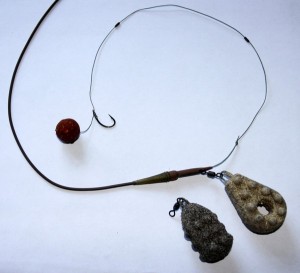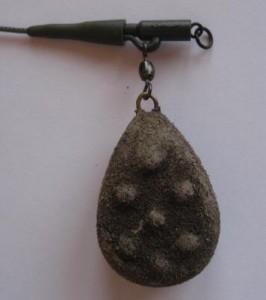
I got talking to a guy on the bank this week about rig safety and how things have changed over the years. If you look back on books written in the 80’s by the likes of Rod H and Kevin Maddocks you’ll see several rigs that while very effective even today, are not up to the current safety standards the sport has come to expect.
Fixed lead systems were first introduced in the late 70’s and coincided with the invention of the boilie and the hair rig. The three fished together suddenly had all takes turning into real flyers. While the bolt rigs, as they were known, were undoubtedly brilliant carp catchers, they caused problems for the fish in the event of a crack off or a breakage.
Now all rigs are safe until the above mentioned event happens. The modern systems give the fish as good a chance as is possible to shed the hook and lead. This however, supposes that the anglers read the instructions and fish the rigs as they are intended by the manufacturer.
Over the last season or so I’ve seen a number of anglers using the ‘Safety’ systems incorrectly which in some cases negates totally the effectiveness they afford and takes us right back to the ‘Death’ rig scenario we used to have before carping awareness of the dangers became common knowledge.
So what are the options and how should they be set up to be safe?
Safety clips:
I believe Kevin Nash was the first to bring these Safety clips out, but I also remember Rod Hutchinson offering a similar idea back in 1993. There are a number of companies now producing these items of end tackle.
I myself use them for the majority of my fishing as they are to my mind, when set up right the safest system that still offers the benefits of the fixed, bolt rig type presentation. My preference goes for a dumpy pear lead in most case.
I will make a couple of points here though, from observations I’ve made over the years. It is quite easy for many of these clips to pull free of the swivel. This to my mind negates the bolt effect of the clip system, as the clip and tubing is then free to slide up the line during the fight. I will concede that in event of a breakage if gives a chance for the whole lot to slide up the line and free the fish. I’ll add here though that this is not a certainty and I can quite easily see the tubing getting stuck or tangled with no possibility for the lead to come off, perhaps some way up the line if you crack off.
I have been using the Korda clips for a long while and my preferred way of setting up the rig is to drill a hole in the clip and tie it on to the swivel, thus preventing it from pulling free. Set up this way in event of a lead getting stuck, plugged or weeded the lead pops off easily. I also think that if I do have the misfortune of leaving a rig in the water the lead will also free the fish without too much problem. The last point I would make here is that it is important to push the tail rubber on just enough to hold the lead in place. If you ram it as far as it will go then in many cases the force needed to pull off the lead is excessive, and more than likely will render the clip system ineffective. There are other makes on the market like the lock jaw clips that snap around the swivel giving the same effect as my tie-on method.
Fished this way I am happy that I have done as much as I can to allow the fish a chance in the event of a breakage. I proved this to myself in France at Old Oaks last year when I had a number of fish landed through the weed. In each case the rig shed the lead, allowing me to easily play the fish in.
Helicopter rigs:
I generally use these for distance fishing when the use of a leader is essential to get the range. Set up properly these rigs are again about as safe as you can get. Set up incorrectly and again we are back to a death rig. The best Helicopter systems I’ve seen recently come from Korda. Their Safe Zone system is excellent. The combination of a leader, buffer bead and sliding bead that you tie in place with PVA string, give a rig that should free the fish fairly easily if you crack off on the cast. The main advantage of a helicopter rig is that properly set up the fish is only left trailing a rig in the case of a mishap.
I must underline here though that properly set up helicopter rigs are essential, and home made jobs or using items that are not meant to go together can quickly see this turned into a fix lead death trap rig.
Running leads:
Now many waters insist on these as the only safe rig for carp fishing. While I can not dispute the safety aspect, I’m not convinced that they offer the best hooking set up that one can use. There is however a whole debate on the subject, as with the barbed/barbless arguments. The only one of this type of set up I’d consider is one that blocks the lead until you get a run. Fox had a set up that involved a ridged tulip bead that fitted over the swivel and where the run ring slipped over it and remained fixed until the fish bolted. Once in action only light pressure was needed to turn it back to a full running rig.
In-line leads:
The last type of set up and one I never use is the in-line lead. There are two reasons I personally dislike this set up, despite the argument that it offers the best immediate resistance to a taking carp, is that I find it hard to see one of these rigs that I feel is safe. Most I’ve seen wedge the lead firmly on to a central plastic clip. Fox do them that are split but I’ve seen these so firmly in place they are hard to pull off. The chances of this type of rig ejecting the lead to my mind are virtually zero. Cast into weed they are a nightmare and to my mind would almost certainly lead to more fish lost.
Lastly they twist the line horribly as the spin during the retrieve. Used in conjunction with a small baitrunner reel the results are horrendous in no time.
I think anglers need to think about their rigs, and tie them as safely as they can. Unless you have 100% confidence that any adaptations you make are totally safe, stick to the set up instructions. Read these carefully and fish safely.

Hi Gareth,
Thanks for raising some very interesting issues on what i consider to be one of the biggest responsibility us Carp anglers have. I would like to add a couple of comments mainly on bolt clips, i always make sure that the clip, tail rubber and swivel are produced by the same manufacturer, ie Korda, ESP, Fox or whoever, i don’t mix them, that way, in theory you should have the correct size swivel fitted in the clip and it should release safely once the fish has bolted. Secondly once the full rig is assembled, get hold of the hooklink, give it a good shake and check that the tailrubber does it’s job and releases the lead as it should do, i know this may seem obvious to most anglers but to those who don’t know, i think it is good practice.
Lastly anybody using any sort of leader or leadcore, please don’t attach your mainline to the leader using a swivel, i have seen 2 examples of this recently, one still attached to a fish with the lead still on and the leadcore pulled through the boltclip and jammed up against a swivel at the top. Very bad practice i think you will agree.
Dave Bainbridge